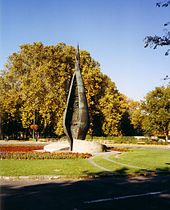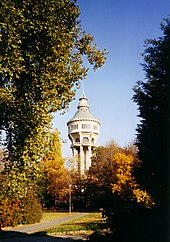Margaret Island (Budapest)

The Margaret Island ( Hungarian Margit-sziget ) is the most famous Danube island in the Hungarian capital Budapest . It is located in the city center, between the two halves of Buda and Pest , and is connected to them by the Margaret Bridge in the south and the Árpád Bridge in the north. The island has a length of about 2.5 km, an area of 0.965 km² and is known and loved by tourists and the people of Budapest as a place to relax because of its extensive parks. Except for taxis, buses and the so-called bringóhintó , denRickshaw- like bicycles, vehicles are prohibited on the island.
history
The history of the city island began with the original name " Rabbit Island" (Hungarian: Nyulak szigete ). In the event of a victory over the Tatars , King Béla IV of Hungary promised to send his daughter Margarete as a nun to the Dominican convent there, to which most of the island belonged. After the Hungarian victory, he kept his promise. His daughter died in the monastery at the age of 28 and was beatified in 1276 . The island finally got its name through numerous legends about the king's daughter Margarete.
It is said that the Turks used the island for their harem ladies before the end of the 18th century . However, the Turks were expelled from the country as early as 1686. At the end of the 18th century, the island fell to the Austrian palatines , who had this place converted into a resort and health resort . The development of thermal springs in the second half of the 19th century emphasized the recreational purpose even more. With the completion of the Margaret Bridge with a kink in 1900, a connection between the small island ( painter's island ) in the southwest and the main island took place. The result is today's expansion. The city acquired the area in 1908, but charged entry fees to enter until 1945 in order to maintain exclusivity. Since then you can visit the island free of charge. In the 1980s in particular, young people from the GDR who hitchhiked through the Eastern Bloc used the island's green spaces for illegal overnight stays. This was primarily due to financial reasons, because the campsites were hardly affordable for GDR citizens with the limited exchange budget. In addition, the GDR hitchhiker scene was among itself here. Towards the end of the 1980s, the Budapest police tolerated this phenomenon less and less and expelled the young people from the island almost every night. As an alternative, an area for free camping was made available in an industrial area on the eastern edge of the city.
Attractions
The most prominent point in the south of Margaret Island is the centenary monument (Hungarian: Centenáriumi emlékmű ) by István Kiss , which commemorates the union of the three cities of Buda , Pest and Óbuda to form the new city of Budapest in 1873. In the middle of the island there are large parking areas that have been laid out in the English style . On the east side are the remains of a Franciscan monastery from the 13th century. To the north of the monastery ruins is a central rose garden with over 2500 different types of roses . There is a small zoo nearby.
Further north are the "ruins" of the Dominican convent, in which the king's daughter Margarete is said to have lived, which has now been restored. During excavations in the 19th century, the grave of the Hungarian King Stephan V with a precious crown was found here. This is also where the promenade begins with numerous busts of important writers, artists and architects.
On the west side of the island is 57 meters high and rising world heritage protected Water Tower . It has been the island's landmark since it was built in 1911 and can be found below an open-air stage.
The St. Michaelis Chapel, part of the Premonstratensian monastery from the 12th century, is located near the Dominican convent . In it is probably the oldest church bell in Hungary from the 15th century. The reconstruction of the chapel in Romanesque style took place in 1931. Today it is still used for church services .
In the north of the island is the Grand Hotel , which was built according to plans by the architect Miklós Ybl in 1873 and was one of the best spa hotels . Next to it is the Danubius Thermal Hotel Margitsziget , which was built on the foundation walls of the former Margaretenbad.
Shortly before the Árpád Bridge is the Japanese Garden from 1936 and the play fountain with Neptune, which is a meeting place for musicians. On the west bank of Margaret Island is the Palatinus Lido, an outdoor thermal pool with a wave pool, water slides and leisure facilities.
gallery
literature
- József Sisa: Margaret Island in Budapest, when it was still called Palatine Island . In: Die Gartenkunst 4 (1/1992), pp. 68–78.
Web links
Individual evidence
- ↑ The Budapest Margaret Island on Budapest Service, accessed on April 16, 2010
Coordinates: 47 ° 32 ' N , 19 ° 3' E







